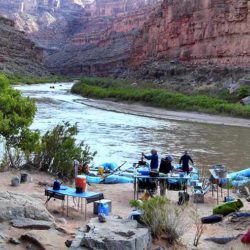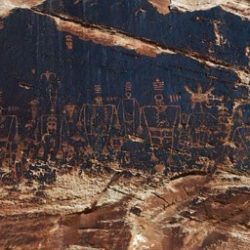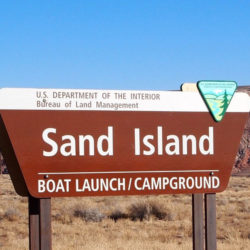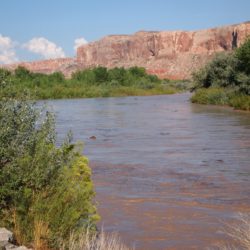No trip to Bluff is complete without a rafting trip down the San Juan River. As you float through the spectacular canyons the San Juan has carved from ancient sandstone, don’t be surprised if you unwind, feel better and lose that nagging feeling to check email.
The San Juan River originates along the slopes of the San Juan Mountains of southwest Colorado. From there, the river flows through northwest New Mexico and southeast Utah before joining the Colorado River at Lake Powell.
A trip down the River offers an intimate way to see the region’s archaeology, geology, and wildlife. Although the river has some rapids, the usually gentle nature of the river makes this an excellent trip for families with children. And, the trip can be as flexible as you want. The stretch from Bluff to Mexican Hat is 27 miles and can easily be traveled in one day, or extended to multiple days. Bluff to Clay Hills is a longer trip, usually taking 5 days.
Three miles west of Bluff is the Sand Island launch site.
You can raft the river on your own, but a permit is required to float the San Juan River. Bluff has well-known rafting company that takes care of all aspects of your river trip and can provide you with a fun, knowledgeable guide who can explain the archaeology, geology and wildlife you will see on the trip. See Guides.
Spring and fall, in particular, are good times to raft the San Juan River. In the spring, snow-pack runoff makes for a faster river. Before you go, you may wish to check the river’s flow rate (CFMs) and water temperature at this site.
Archeology
The archeological record along the San Juan River between Bluff and Mexican Hat is unsurpassed. World-class rock art panels and cliff dwellings are easily accessible. At the Sand Island launch site is a large, easily accessible petroglyph panel. At the confluence of Butler Wash and the San Juan River, rafters float past the famous Butler Wash Petroglyph Panel (also known as the Big Kachina Panel) with its well-known San Juan Anthropomorph figures dating to Basketmaker times. This is one of the most important petroglyph panels in the Southwest.
River House ruin is a stabilized ruin that is a popular stop for rafters. At the ruin you can walk in the stabilized ruin, admire the rock art and examine fragments of pottery and stone tools. River House was occupied by Ancestral Puebloans between AD900 and the late 1200s.
Please remember to Visit with Respect. All artifacts and the ruin itself are protected by law. It is illegal to remove artifacts or damage the ruin. Violations of the Archeological Resources Protection Act can result in stiff penalties.
Geology
The river also offers a chance to see “textbook geology” such as the spectacular canyons of the Goosenecks of the San Juan.
General Info
Fees and Permits:Fees to raft the river vary depend on the length of your river trip. BLM permits are required to float any section of the San Juan River. Permits are available at recreation.gov through a pre-season lottery and advance reservations to individuals 18 and older. Please do not expect to show up at the launch ramp without a permit expecting to launch or join another group.
Camping: Camping is available at Sand Island Campground and Comb Ridge Campground, as well as at various other campgrounds below Government Rapid.
Directions: Sand Island Boat Launch is 4 miles west of Bluff on Highway 191.
Telephone: BLM River Office 435-672-1544; BLM Monticello Office is (435) 587-1500.
Nearby Attractions
Sand Island Petroglyphs is on the banks of the San Juan River near Bluff. Learn more about rafting the river from Bluff and the sites you’ll see along the way.







